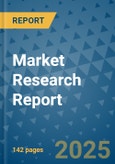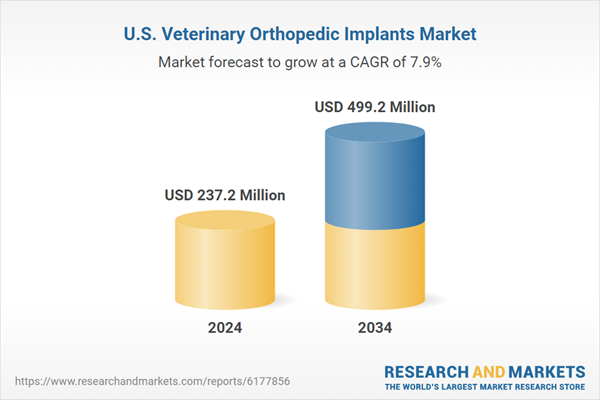The market is witnessing substantial growth as pet owners increasingly prioritize advanced medical care for their animals, particularly surgical interventions that restore mobility and enhance quality of life. Veterinary orthopedic implants, including prosthetic joints, screws, plates, wires, and pins, are critical in treating fractures, joint disorders, and bone injuries across various animal species. These devices, commonly made from stainless steel or titanium, are engineered to endure high biomechanical stress while offering long-term durability and functionality. Market growth is further driven by continuous advancements in implant materials such as bioresorbable polymers and titanium-based alloys, which offer improved strength, biocompatibility, and faster healing. Additionally, veterinarians are increasingly opting for implants that align with minimally invasive procedures, enabling reduced recovery times, smaller incisions, and lower post-surgical complications. As veterinary medicine advances, the market continues to benefit from ongoing innovation, increasing surgical precision, and expanding access to orthopedic solutions that promote better outcomes for both companion animals and livestock.
In 2024, the joint replacement segment held a share of 28.3%. This segment includes procedures involving the hip, knee, ankle, and elbow, and is gaining traction due to the growing occurrence of joint-related conditions in animals. The segment is seeing rapid innovation, with a notable shift toward the use of custom-designed, 3D-printed implants that offer better fit, reduce surgical errors, and improve compatibility. These technological advancements are contributing significantly to the broader adoption of joint replacement surgeries across veterinary care practices.
The veterinary hospitals and clinics segment generated USD 203.4 million in 2024 and is expected to witness a CAGR of 8.1% through 2034. These facilities remain the primary centers for diagnosing and managing orthopedic issues such as fractures, ligament damage, and degenerative joint conditions in animals. The growing number of veterinary professionals and advanced surgical infrastructure is enabling better access to high-quality implant procedures. The continuous expansion of clinics and hospitals equipped with specialized orthopedic tools and skilled surgeons is accelerating growth in this segment, making it a vital contributor to the overall market.
Florida Veterinary Orthopedic Implants Market generated USD 10.4 million in 2024. The increase in orthopedic issues, injuries, and age-related bone disorders in pets is fueling demand for innovative surgical implants. The state’s growing population of aging animals, combined with rising pet ownership and access to veterinary care, continues to support regional market development and adoption of orthopedic implant solutions.
Leading companies active in the U.S. Veterinary Orthopedic Implants Market include Orthomed, B. Braun, Movora (Vimian Group), AmerisourceBergen Corporation (Cencora), Veterinary Instrumentation, Arthrex Vet Systems, Rita Leibinger, GPC Medical, Integra LifeSciences, Fusion Implants, BlueSAO, Narang Medical Limited, DePuy Synthes (Johnson & Johnson), Ortho Max, and GerVetUSA. To strengthen their position in the market, companies are heavily investing in R&D to develop implants that offer greater biocompatibility and support faster healing. Brands like Veterinary Instrumentation, Arthrex Vet Systems, and GerVetUSA are focusing on expanding their product portfolios with minimally invasive and custom-fit implant systems. Collaborations with veterinary hospitals and academic institutions are enabling deeper market penetration and end-user engagement. Businesses are also enhancing their manufacturing capabilities by introducing precision-engineered implants and improving distribution channels to reach a broader customer base.
Comprehensive Market Analysis and Forecast
- Industry trends, key growth drivers, challenges, future opportunities, and regulatory landscape
- Competitive landscape with Porter’s Five Forces and PESTEL analysis
- Market size, segmentation, and regional forecasts
- In-depth company profiles, business strategies, financial insights, and SWOT analysis
This product will be delivered within 2-4 business days.
Table of Contents
Companies Mentioned
The companies profiled in this U.S. Veterinary Orthopedic Implants market report include:- AmerisourceBergen Corporation (Cencora)
- Arthrex Vet Systems
- B. Braun
- BlueSAO
- DePuy Synthes (Johnson & Johnson)
- Fusion Implants
- GerVetUSA
- GPC Medical
- Integra LifeSciences
- Movora (Vimian Group)
- Narang Medical Limited
- Ortho Max
- Orthomed
- Rita Leibinger
- Veterinary Instrumentation
Table Information
| Report Attribute | Details |
|---|---|
| No. of Pages | 142 |
| Published | September 2025 |
| Forecast Period | 2024 - 2034 |
| Estimated Market Value ( USD | $ 237.2 Million |
| Forecasted Market Value ( USD | $ 499.2 Million |
| Compound Annual Growth Rate | 7.9% |
| Regions Covered | United States |
| No. of Companies Mentioned | 16 |









